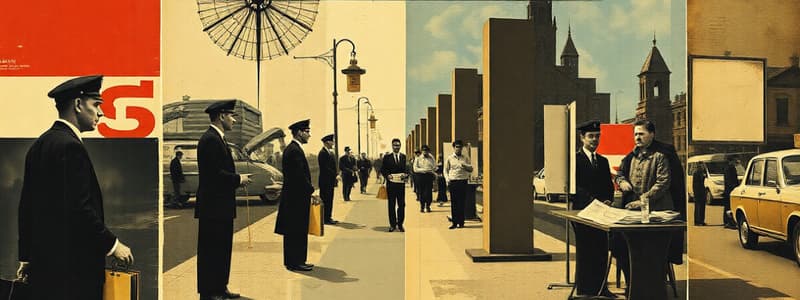Podcast
Questions and Answers
Which of the following best describes the controlling function in management?
Which of the following best describes the controlling function in management?
- Planning future goals
- Monitoring and regulating activities (correct)
- Creating new strategies
- Directing employees
Why is control important in the management process?
Why is control important in the management process?
- It promotes creativity and innovation.
- It allows for better employee relationships.
- It ensures that organizational activities meet set objectives. (correct)
- It helps to create a vision for the company.
Control in management helps managers to:
Control in management helps managers to:
- Communicate with suppliers.
- Develop employee morale.
- Create a strong company culture.
- Ensure that resources are used effectively. (correct)
What is the first step in the control process?
What is the first step in the control process?
Which type of control occurs while activities are taking place?
Which type of control occurs while activities are taking place?
A financial control that compares budgeted expenses with actual expenses is known as:
A financial control that compares budgeted expenses with actual expenses is known as:
Which of the following is not a type of control?
Which of the following is not a type of control?
When a manager sets a performance goal for the next quarter, they are engaging in:
When a manager sets a performance goal for the next quarter, they are engaging in:
In control processes, a standard is best defined as:
In control processes, a standard is best defined as:
Which of the following is an example of a feedforward control?
Which of the following is an example of a feedforward control?
Which control technique involves setting limits on expenses within departments?
Which control technique involves setting limits on expenses within departments?
A balanced scorecard typically includes which of the following perspectives?
A balanced scorecard typically includes which of the following perspectives?
The control process that compares performance to internal standards rather than industry benchmarks is called:
The control process that compares performance to internal standards rather than industry benchmarks is called:
When managers compare their company’s performance with competitors, they are engaging in:
When managers compare their company’s performance with competitors, they are engaging in:
The Six Sigma approach focuses on:
The Six Sigma approach focuses on:
Which tool is used to identify and eliminate causes of problems in processes?
Which tool is used to identify and eliminate causes of problems in processes?
Which control technique focuses on comparing productivity across different departments or industries?
Which control technique focuses on comparing productivity across different departments or industries?
A common tool for ensuring quality in manufacturing is:
A common tool for ensuring quality in manufacturing is:
An internal audit is used to:
An internal audit is used to:
What is one benefit of using benchmarking in control processes?
What is one benefit of using benchmarking in control processes?
Flashcards are hidden until you start studying
Study Notes
Module Outcome 1: Understanding the Role of Control in Management
-
Controlling function in management: Monitoring and regulating activities to ensure they meet objectives.
-
Importance of control: Ensures organizational activities align with set objectives.
-
Control helps managers: Ensure effective resource utilization.
-
First step in the control process: Setting performance standards.
-
Concurrent control: Control implemented while activities are ongoing.
-
Budgetary control: Comparing budgeted and actual expenses.
-
Control types: Feedforward, concurrent, and feedback. Strategic alignment is not a control type.
-
Setting a performance goal: This is a planning activity.
-
Standard (in control processes): A norm for measuring performance.
-
Feedforward control example: Setting quality controls before production begins.
Module Outcome 2: Identifying Control Techniques in Different Organizational Levels
-
Control technique limiting departmental expenses: Budgeting.
-
Balanced scorecard perspectives: Financial, customer, internal business processes, and learning & growth.
-
Comparing performance to internal standards: Management by Objectives (MBO).
-
Comparing company performance to competitors: Benchmarking.
-
Six Sigma focus: Reducing process errors.
-
Tool for identifying and eliminating problem causes: Control charts.
-
Control technique comparing productivity across departments/industries: Benchmarking.
-
Quality control tool in manufacturing: Total Quality Management (TQM).
-
Purpose of an internal audit: Ensuring adherence to internal policies and procedures.
-
Benefit of benchmarking: Identifying industry best practices.
Studying That Suits You
Use AI to generate personalized quizzes and flashcards to suit your learning preferences.



